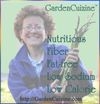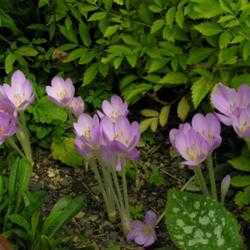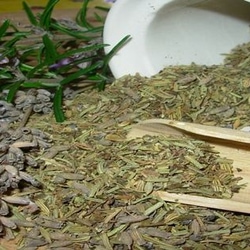Autumn Blooming Crocus
Many of us think of the crocus as a spring bloomer, but did you know there are many varieties of Fall bloomers too? Autumn blooming crocuses include an array of colorful blossoms in shades of lavender-blue, white and yellow. Species of fall crocuses include 'Aino'; 'Oxonian'; and Crocus pulchellus - a lovely species for rock gardens - available in yellow or violet blue shades. Crocus sativus is the fall blooming crocus with gorgeous violet color blooms known for stigmas that produce the most expensive spice in the world, saffron.
 Saffron crocus does not grow wild and is cultivated by man. Its round-shaped corms actively awaken from dormancy about 40 days after planting, during the cooler temperatures in early fall. Lovely lilac blooms emerge for 20 to 30 days, featuring six tepals on low growing plants during October and November. Crocus sativus is a drought-tolerant member of the Iridaceae (Iris) family and prefers full sun.
Saffron crocus does not grow wild and is cultivated by man. Its round-shaped corms actively awaken from dormancy about 40 days after planting, during the cooler temperatures in early fall. Lovely lilac blooms emerge for 20 to 30 days, featuring six tepals on low growing plants during October and November. Crocus sativus is a drought-tolerant member of the Iridaceae (Iris) family and prefers full sun.
Saffron Crocus (Crocus sativus)
Man's use of Saffron dates all the way back to around 1600 B.C.E. Popular in kitchen garden, it's harvested for food coloring or flavoring. Commercially, saffron is used to dye textiles and finds applications in manufacture of incense, cosmetics and perfumes. In medicine, prescriptions used by Rheumatologists to treat gout contain the potent chemical colchicine, found in the autumn crocus.
Saffron Spice
The stigmas are the female part of the flower. Upon close inspection, you will notice that every flower has three stigmas. The stigmas are the red-orange part of the saffron crocus that is used for commercial  saffron sold in markets. The stamens are the yellow male part; they are usually discarded and not used.
saffron sold in markets. The stamens are the yellow male part; they are usually discarded and not used.
"Safra" means yellow in Persian. The vibrant yellow-orange saffron color imparted to foods comes from soaking the stigmas in warm liquid. Saffron is cultivated around the world including Persia (Iran), the world's largest producer, and in: Spain, Morocco, Kashmir, Italy, Greece, Afghanistan, Australia, Austria, China, Japan, Egypt, France, India, Israel, Pakistan, Turkey, and Switzerland.
In Spain celebrations and contests in honor of saffron harvests are held annually. One fun event demonstrates how fast contestants can 'Monda' (detach the three stigmas from the flower) at La Fiesta de la Rosa del Azafrán de Consuegra.
Saffron is also sold in extract form, as a dietary supplement, for its alleged antioxidant power and possible effectiveness in uplifting those suffering from depression and premenstrual syndrome (PMS).[1] More studies need to be done to validate its effectiveness as an anti-cancer agent and its association with decreasing cholesterol and triglyceride levels in the blood.
Saffron in Cooking
The flower petals and sitgmas are the parts of the Saffron crocus used for culinary purposes. The orange-red stigmas produce the spice, saffron, and make a yellow dye when steeped. True saffron flavor has been described as bitter, yet savory.
When used sparingly, quality saffron adds rich golden color, nutrition and flavor to foods, including traditional Spanish cuisine and risotto Milanese. Other foods enhanced by saffron include:
| • Rice • Paella • Seafood • Stews • Bouillabaisse • Broth • Sauces • Teas • Curry spice blends • Biryani spice blend • Breads • Desserts |
Saffron Nutrition
Kaempferol, a flavonoid found in saffron petals and the carotenoid crocin - a water-soluble antioxidant pigment - give saffron its vibrant yellow color. According to the USDA National Nutrition Database for Standard Reference, ¼ teaspoon of Saffron spice is a good source of Vitamin B6, Iron and Potassium, and a very good source of Vitamin C, Magnesium and Manganese. Saffron should be used sparingly to avoid possible harm from too much of its potent chemical constituents.
Adverse Reactions to Saffron
For most people saffron spice is well tolerated and not a problem; however, in some susceptible individuals, anaphylactic reactions can occur. Saffron should always be used in moderation - amounts greater than 5 grams have been shown to be dangerous.[2] However, since saffron stigmas are very light, you would need quite a lot of saffron for more than 5 grams. In the U.S., saffron has a Generally Recognized as Safe (GRAS) status.
Saffron threads vs. powder
An acre of land produces less than 10 pounds of hand-picked saffron stigmas. Costing thousands of dollars per pound, saffron is also known as 'red gold'. Is it any wonder that some suppliers may try and stretch pure saffron with other products?
Powdered saffron might not be 100% saffron if it's not purchased from a reputable source. If you plan to buy saffron, rather than growing your own, be aware that saffron powder loses flavor quickly and lends itself to being adulterated or stretched with similar looking products like turmeric. So, select your spice provider cautiously. If you are worried about getting true saffron, you may prefer to purchase saffron threads, as opposed to saffron powder.
Footnotes: [1] [2] Jellin JM, Gregory PJ, et al. Pharmacist's Letter/Prescriber's Letter Natural Medicines Comprehensive Database. 12th edition. Stockton, CA: Therapeutic Research Faculty; 2009
Photo Credits: Saffron threads photo courtesy of Rainer Zenz, Wikipedia. Crocus sativus bloom courtesy of KENPEI taken in Osaka-fu, Japan, Wikipedia GNU Free Documentation License. Photograph of Autumn Crocus 'Oxonian' used with permission from Dave's Garden member Galanthophile Copyright © 2010, all rights reserved.
Related DG Articles: The Subtle Saffron: Growing and Using by Darius Van d'Rhys
Related Links: Saffron Recipes
Golden Saffron Quinoa with Roasted Cheezy Broccoli

















